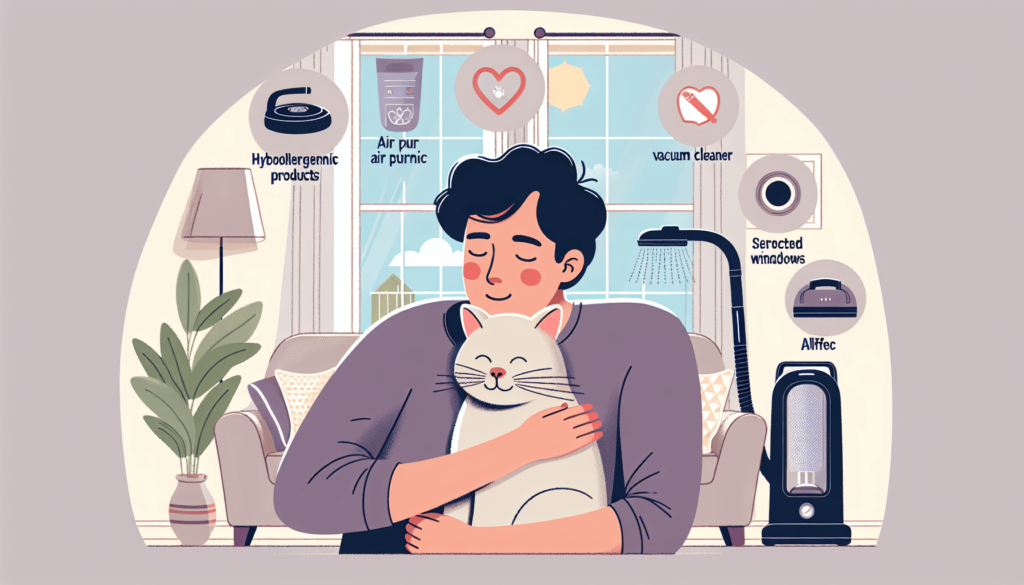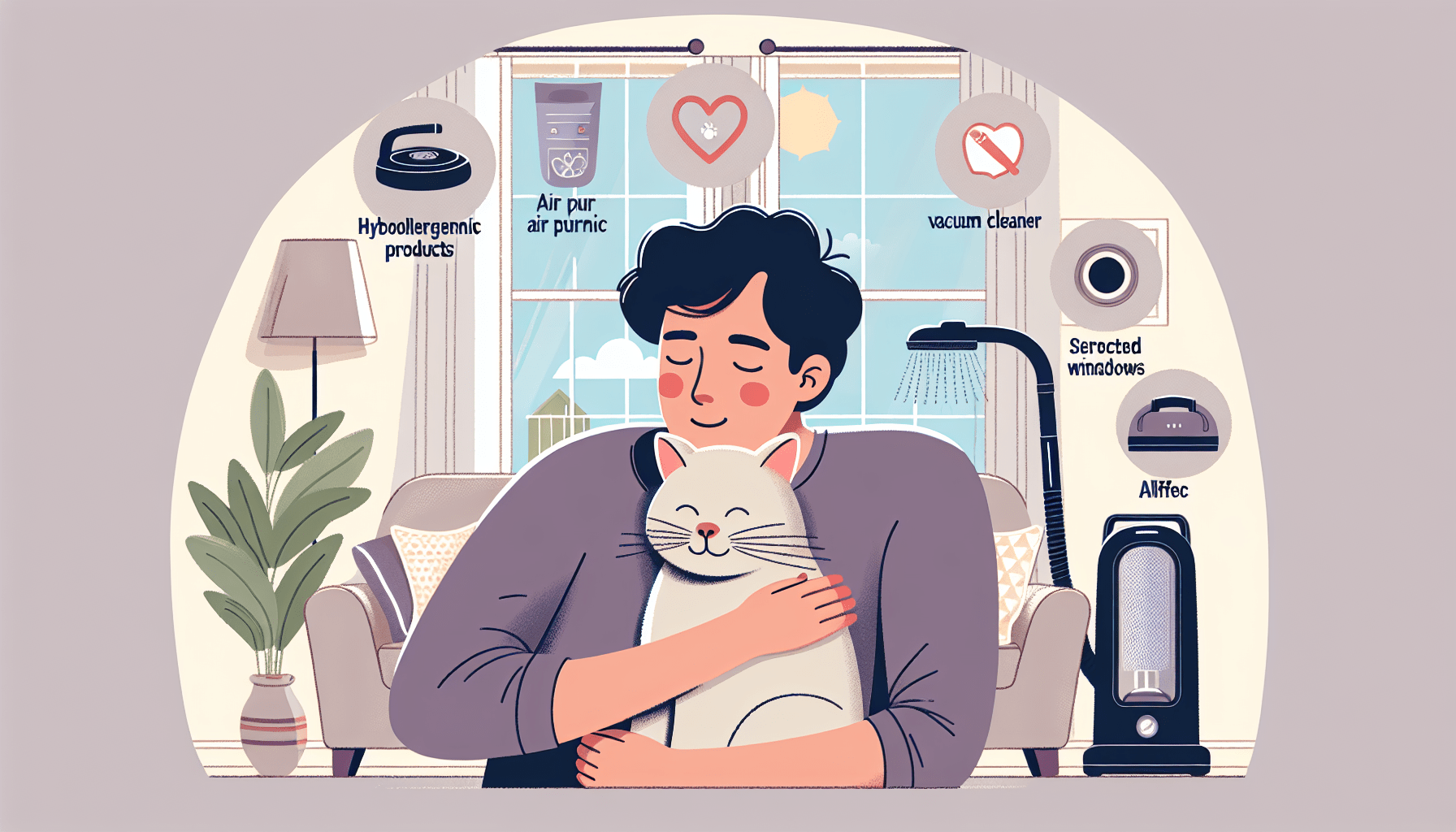Having a pet can bring immense joy and companionship to your life, but for those with pet allergies, it can also come with some challenges. In this article, we will explore various strategies and techniques on how to cope with pet allergies, so that you can continue to enjoy the company of your furry friend without suffering from constant sneezing and itching. From effective cleaning methods to allergy-friendly pet choices, we’ve got you covered. So, let’s dive in and discover how you can live harmoniously with your beloved pet, even if you have allergies.

Understanding Pet Allergies
Pet allergies are a common condition that many people have to manage. It occurs when your immune system overreacts to substances found in an animal’s skin cells, saliva, or urine. The most common pet allergies are caused by dogs and cats, but it is possible to be allergic to other animals as well. Understanding pet allergies is crucial in order to effectively cope with them.
Identifying Pet Allergies
Identifying pet allergies can be a daunting task, as the symptoms can vary from person to person. However, there are some common signs that may indicate an allergic reaction. These include sneezing, coughing, itchy or watery eyes, runny nose, congestion, and skin rashes. If you experience these symptoms consistently when you are around animals, it is likely that you have a pet allergy.
Common Symptoms of Pet Allergies
Pet allergies can cause a wide range of symptoms, some of which can be quite bothersome. In addition to the typical symptoms mentioned earlier, pet allergies can also lead to asthma attacks, difficulty breathing, chest tightness, and even hives or eczema. It’s important to pay attention to these symptoms and seek medical advice if they persist or worsen.
Types of Pet Allergies
There are different types of pet allergies, depending on the specific allergen that triggers the reaction. The most common type is an allergy to an animal’s dander, which is made up of tiny flakes of skin. Other common allergens include proteins found in an animal’s saliva or urine. It is also possible to be allergic to specific breeds of animals, as some produce more allergens than others.
Diagnosing Pet Allergies
If you suspect that you have pet allergies, it is important to seek medical advice for a proper diagnosis. The following methods are commonly used to diagnose pet allergies:
Seeking Medical Advice
The first step in diagnosing pet allergies is to consult a healthcare professional. They will ask you about your symptoms and medical history, as well as perform a physical examination. They may also refer you to an allergist for further testing.
Allergy Testing
Allergy testing can help identify the specific allergens that trigger your pet allergies. The most common type of allergy testing is a skin prick test, where small amounts of allergens are applied to your skin to see if there is a reaction. Blood tests can also be used to measure allergen-specific antibodies in your blood.
Elimination Diet
In some cases, your doctor may suggest an elimination diet to identify the specific animal or allergen that is causing your symptoms. This involves removing one potential allergen at a time from your environment or diet to see if your symptoms improve. This method can be time-consuming and requires patience, but it can provide valuable information about your pet allergies.
Managing Pet Allergies at Home
Once you have been diagnosed with pet allergies, there are several steps you can take to manage the symptoms and reduce exposure to pet allergens at home:
Create Pet-Free Zones
Designate certain areas of your home as pet-free zones to minimize your exposure to pet allergens. For example, you can keep pets out of your bedroom to ensure that you have a restful and allergen-free environment when you sleep.
Frequent Cleaning and Vacuuming
Regular cleaning and vacuuming are essential to reduce the amount of pet allergens in your home. Use a vacuum cleaner with a HEPA filter to effectively trap allergens, and consider using damp cloths or mops to capture allergens on surfaces.
Air Purifiers and Filters
Investing in air purifiers and filters can significantly reduce the levels of pet allergens in your home. Look for products that are specifically designed to capture pet dander and other allergens. Place these devices in frequently used areas such as the living room or home office to improve air quality.
Choosing Allergy-Friendly Pets
If you are a pet lover but suffer from pet allergies, there are still options available to you. Consider the following when selecting a pet that is less likely to trigger your allergies:
Hypoallergenic Dog Breeds
Some dog breeds are considered hypoallergenic, meaning they produce fewer allergens or shed less. Breeds such as poodles, bichon frises, and Portuguese water dogs are known to be more allergy-friendly. However, it’s important to note that individual reactions can still vary, so spend time with the specific breed you are interested in to see if it triggers any symptoms.
Non-Shedding Cat Breeds
Similarly, certain cat breeds are known to produce fewer allergens or shed less, making them better options for allergy sufferers. Some examples include Russian blues, Bengal cats, and Sphynx cats. As with hypoallergenic dogs, spend time with the specific breed to ensure that it doesn’t trigger your allergies.
Alternative Pets for Allergy Sufferers
If you have severe allergies or are unable to tolerate any exposure to pet allergens, consider alternative pets that do not have fur or produce allergens. Some options include fish, reptiles, or even birds. However, it’s essential to research the specific care needs of these pets to ensure that they are suitable for your lifestyle.

Reducing Exposure to Pet Allergens
In addition to managing pet allergies at home, there are simple strategies you can implement to reduce your exposure to pet allergens:
Regular Grooming and Bathing
Regularly grooming and bathing your pet can help decrease the amount of allergens they produce. Brushing your pet’s fur and wiping them down with pet-safe wipes can remove dander and reduce allergen levels. If your pet tolerates it, bathing them regularly with hypoallergenic shampoos can also be beneficial.
Keep Pets Out of Bedrooms
As mentioned earlier, keeping pets out of your bedroom can provide a safe haven free from pet allergens while you sleep. This can significantly improve your sleep quality and reduce symptoms.
Wash Pet Bedding Regularly
Washing your pet’s bedding, blankets, and toys frequently can help eliminate allergens that may accumulate on these items. Use hot water and hypoallergenic detergents to ensure thorough cleaning and minimize any potential exposure to allergens.
Medications for Pet Allergies
If managing pet allergies through environmental control is not sufficient, there are several medications available that can help alleviate symptoms:
Over-the-Counter Allergy Medications
Over-the-counter antihistamines, such as cetirizine or loratadine, can help relieve common allergy symptoms like sneezing and itchy eyes. These medications are readily available and can be effective for mild allergies. However, it’s important to read and follow the instructions on the labels.
Prescription Medications
In more severe cases, your doctor may prescribe stronger medications to manage your pet allergies. These may include prescription-strength antihistamines, nasal sprays, or corticosteroids. It’s essential to follow your doctor’s instructions and report any side effects or concerns.
Immunotherapy (Allergy Shots)
Immunotherapy, commonly known as allergy shots, is a long-term treatment option for pet allergies. It involves receiving regular injections of small amounts of the allergen over time, which gradually desensitize your immune system to pet allergens. This can reduce or eliminate your allergic response to pets altogether.
Natural Remedies for Pet Allergies
In addition to medications, some people find relief from pet allergies through natural remedies:
Saline Nasal Rinse
Using a saline nasal rinse can help relieve nasal congestion and flush out allergens. It involves rinsing your nasal passages with a saltwater solution. Saline nasal rinses can be purchased at pharmacies or made at home using distilled water and non-iodized salt.
Steam Inhalation
Inhaling steam from a bowl of hot water or using a steam inhaler can help alleviate congestion and soothe irritated airways. Adding a few drops of essential oils, such as eucalyptus or peppermint, to the hot water can enhance the benefits.
Quercetin Supplements
Quercetin is a flavonoid found in certain fruits and vegetables, known for its antihistamine properties. Some people find relief from pet allergies by taking quercetin supplements. However, it’s important to consult with a healthcare professional before starting any new supplements to ensure they are safe and appropriate for you.
Managing Allergies When Visiting Others
When visiting friends or family who have pets, it’s important to take preventative measures to minimize exposure to pet allergens:
Communicate Your Allergies
Inform your hosts about your pet allergies before your visit. This allows them to make necessary preparations, such as cleaning or keeping their pets in separate areas. Open communication can help create a more allergy-friendly environment for you.
Take Preventative Measures
Consider taking allergy medications before visiting homes with pets. This can help alleviate symptoms and reduce the chances of an allergic reaction. Additionally, wearing long sleeves and pants, avoiding pet contact, and washing hands frequently can further minimize exposure to allergens.
Carry Allergy Medications
Always carry your prescribed allergy medications with you when visiting others. In case of an unexpected allergic reaction, having medications on hand can provide quick relief and prevent symptoms from escalating.
Seeking Support for Pet Allergies
Living with pet allergies can be challenging, but there are support systems available to help you cope:
Join Support Groups
Consider joining support groups for individuals with pet allergies. These groups can provide a sense of community, valuable tips, and emotional support from people who understand your experiences.
Consult Allergists and Veterinarians
Allergists and veterinarians are experts in managing pet allergies and can provide you with tailored advice and treatment options. Don’t hesitate to reach out to them for guidance and support.
Talk to Family and Friends
Discuss your pet allergies with your family and friends, as they can offer support and make accommodations to ensure your comfort. By educating your loved ones about your allergies, you can create a more understanding and inclusive environment for everyone.
Considering Alternative Options
If you are unable to have a pet due to allergies, there are still ways to enjoy the companionship of animals:
Fostering or Pet Sitting
Consider fostering or pet sitting for short periods of time. This allows you to enjoy the benefits of having a pet without committing to long-term ownership. Fostering or pet sitting can also help animal shelters by providing temporary care for their animals.
Volunteering at Animal Shelters
Volunteering your time and skills at animal shelters can be a fulfilling way to interact with animals and contribute to their well-being. Many shelters need assistance with various tasks, such as feeding, grooming, or exercising the animals.
Adopting a Pet That Doesn’t Trigger Allergies
Finally, if you’ve successfully managed your pet allergies and are ready for a long-term furry companion, consider adopting a pet that doesn’t trigger your allergies. Research specific breeds or animals that have been known to be allergy-friendly, and spend time with potential adoptees to ensure compatibility.
In conclusion, managing pet allergies requires a combination of awareness, preventative measures, and medical support. By understanding pet allergies, identifying symptoms, and taking the necessary steps to reduce exposure to pet allergens, you can better cope with this common condition. Whether it’s through medication, natural remedies, or lifestyle adjustments, there are various approaches to managing pet allergies and still enjoying the company of animals. Remember to seek support from professionals, join support groups, and communicate with your loved ones to ensure holistic care and understanding.

